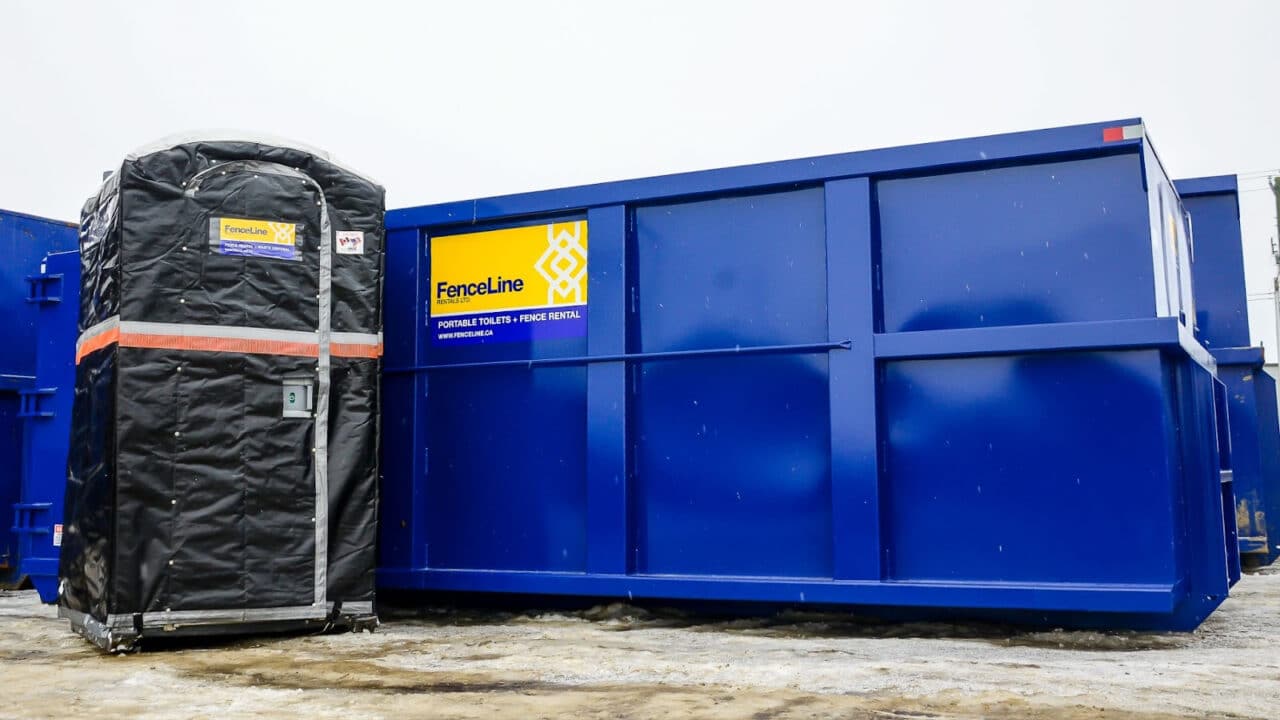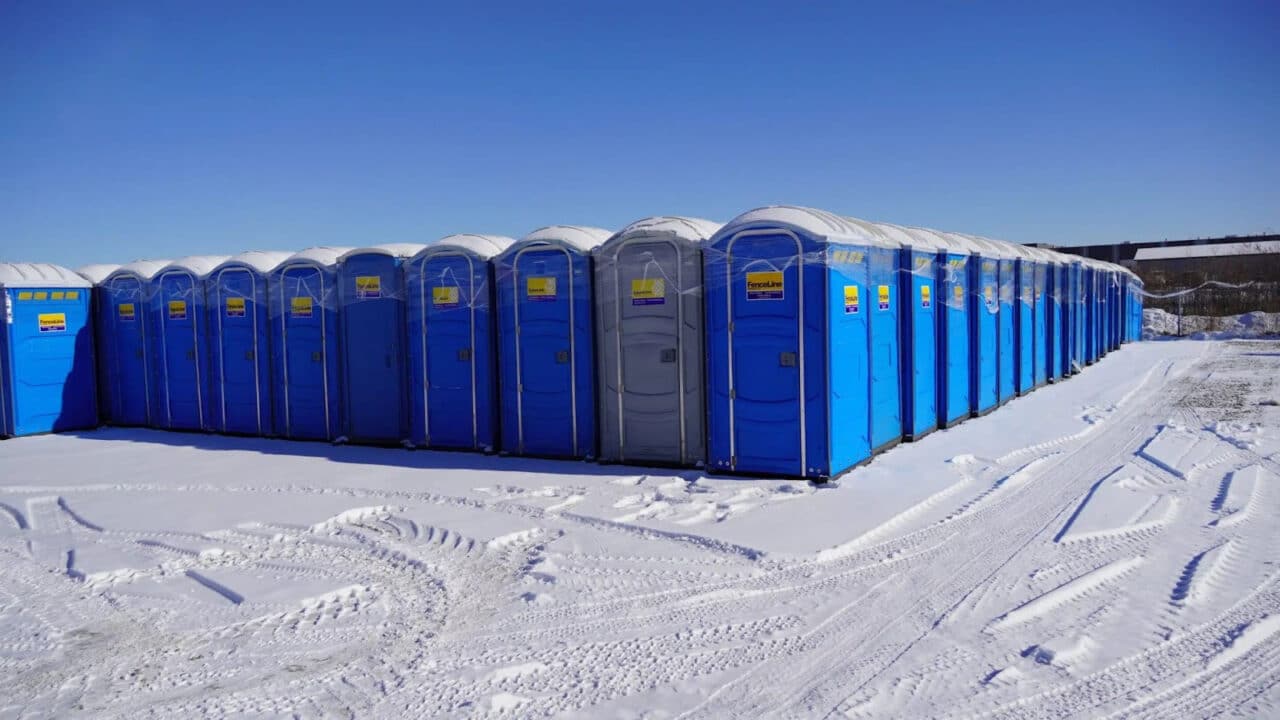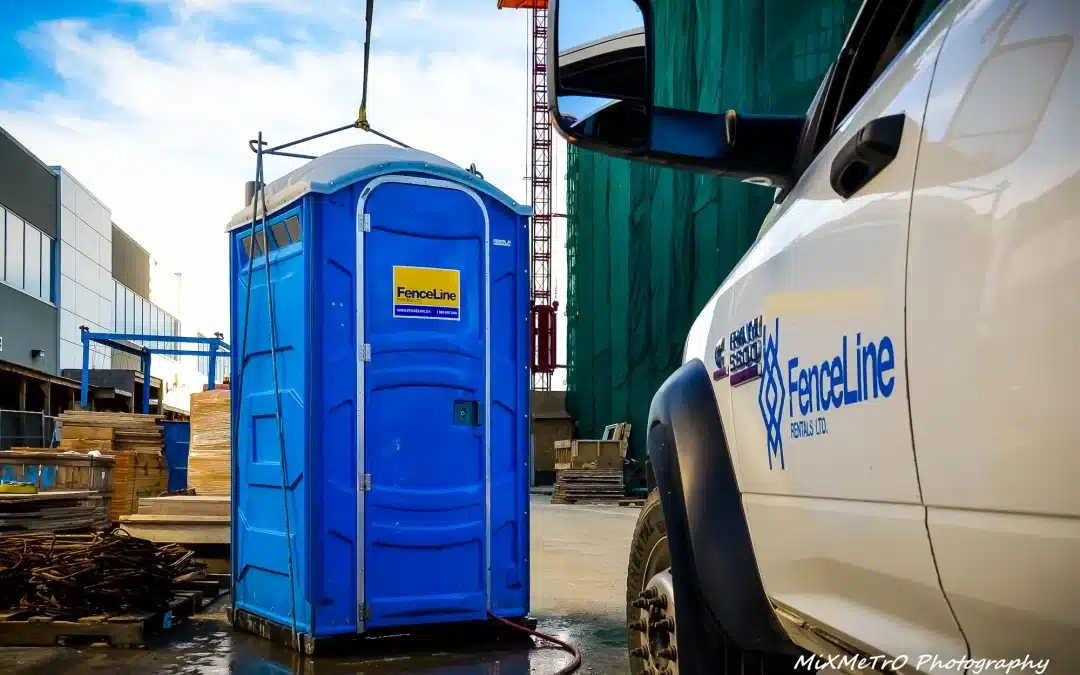Porta potties perform a vital function at outdoor events and on construction sites. They keep your site clean and sanitary while providing a comfortable place for your guests or workers to use the facilities. It’s absolutely vital that they be maintained properly, though, as it makes a huge difference in the experience of using them.
In this guide, we’ll give you all the information you need about porta potty cleaning and maintenance, including:
- How porta potties work
- How to prepare your site for portable toilets and how to maintain them
- How to clean your portable toilets
- How to winterize your portable toilets
- What types of portable toilets are available
How Do Porta Potties Work?
Understanding how portable toilets work is important to making sure they’re clean and well-maintained. After all, porta potties are something most people see around town regularly, but they might not necessarily know how they actually work. There are a few key things to understand:
- Self-Contained Systems: Porta potties don’t need plumbing, which allows them to be set up in remote areas where there’s no connection to sewers. Each unit is self-contained with a toilet seat, holding tank, and ventilation.
- Holding Tank: The holding tank is located beneath the toilet seat in the porta potty and it collects waste. It contains blue deodorizing chemicals that break down waste, control odors, and kill bacteria.
- Vents: There are vents at the top of every unit that allow gases to escape, helping to minimize odours.
- Added Features: Not every portable toilet is the same, and you can add features like hand sanitizer dispensers. It’s important to have handwashing stations nearby.
- Maintenance: When maintained properly and cleaned regularly, portable toilets are comfortable and appealing for the people who need to use them. We’ll get into the best practices for cleaning and maintaining portable toilets in the next section.
How to Prepare & Manage Your Portable Toilets

Whether you’re running an outdoor event or managing a construction site, portable toilets are an essential tool for keeping things sanitary and clean. They do need to be properly managed, though, and you should prepare your site for portable toilets to be installed beforehand.
Preparing for Portable Toilets
Every site presents a challenge, whether that’s for a construction site in an urban area with limited space or an outdoor event like a music festival. There are a few key things you can prepare for before you even set up your portable toilets.
- Know how many people will be using your portable toilet: This will allow you to ensure they aren’t overused. The general rule is that you should have one portable toilet for every 50 people attending, although you should have slightly more if you will be serving food and drink
- Find hard, flat surfaces: A parking lot is ideal, as it provides stability and mess-free areas that reduce mud being tracked in, creating slippery and dirty conditions. You can also place portable toilets on grass, gravel, or dirt.
- Find areas that are sheltered: This can help block the hot sun in the summer, which can cause portable toilets to overheat, as well as keep them out of the wind and rain.
Essentials for Maintaining Portable Toilets
Maintaining portable toilets is essential work. It ensures that they remain clean, hygienic, and appealing for everyone to use. Here are some key tips for maintaining your porta potties:
- Clean portable toilets once a week: This depends on usage, and for high-volume events and construction sites, you should consider cleaning them more often. When they’re getting cleaned, portable toilets should be completely pumped, and the hose should be all the way at the bottom and to the side to prevent debris from being sucked into the hose and clogging it.
- Refill the septic tank: This is a critical piece of cleaning a portable toilet, as the septic tank should be refilled with an additive that breaks down and cleans the waste.
- Keep fresh air flowing: In between cleanings, make sure the door isn’t closed at all times. Leaving it open allows odors to disperse and air to circulate. You should also keep the door open during the cleaning itself
- Wash surfaces: Floors, sinks, and the portable toilet seats should be cleaned regularly with warm, soapy water. A pressure water gun can remove germs, too, and routine cleaning and maintenance will ensure the health, safety, and integrity of the toilet.
- Dispose of waste with a certified and regulated company: Human waste can be hazardous to our health, so it’s important to make sure it’s disposed of properly.
5 Ways to Keep Portable Toilets Clean

1. Be Ready for Your Guests & Staff
One of the most important steps you can take to keep your porta potties clean and fresh is simple: Make sure you’ve got enough units.
Knowing how many people are likely going to be attending your event, as well as how long your event is going to last, is critical. The typical rule of thumb is that for every four hours, you need one portable toilet for every 50 people. When there’s food and alcohol at your event, this number should increase.
Additionally, more portable toilets are needed if there are significantly more women than men, and the total should increase by 10%-20%. If the portable toilets are being used for a work site, a good number is one toilet per 10 workers.
Use our free portable toilet calculator to find out how many toilets you need for your event or job site.
2. Ensure Your Portable Toilet Receives Service
If your portable toilet units smell bad, it tells the world that there’s a lack of cleanliness and that health and safety might not be being taken as seriously as they should be. Depending on how many people are using it, a portable toilet should be cleaned once a week.
When choosing FenceLine Rentals Ltd. for your porta potty rental, our team will service your toilet weekly.
Here’s what the process looks like:
- The unit will be completely pumped, and the hose should be all the way at the bottom and to the side to prevent debris from being sucked and clogging the hose.
- The waste tank is refilled with an additive that breaks down and cleans the waste.
- The door to the unit will be kept open, allowing the odours and air to circulate. Fresh air is also important to provide between cleanings.
- We’ll clean surfaces with warm, soapy water to remove germs, dirt, and grime.
Routine cleaning and maintenance ensure the health, safety, and integrity of the toilet. The waste can be hazardous if not disposed of carefully and properly. Therefore, waste management should be performed by a certified and regulated company for the best maintenance and safety of the toilets.
3. Maintain a Sufficient Supply of Hygiene Products
Don’t leave your guests or staff guessing. Make sure all of your portable washrooms are well stocked.
Handwashing stations, soap, paper towels, hand sanitizer, toilet paper, and disinfectant wipes are all fundamental to keeping portable toilets fully functioning. When your toilets are supplied and clear expectations are set, it is easier for those using them to maintain healthy hygiene habits.
4. Deodorize
Cleaning portable toilets and keeping them supplied is important, but don’t forget that having products to control odours is also helpful. Most professionals rely on products with the deepest blue colors to control and mask odors and sights.
These products should contain 4 main components: biocides, dyes, fragrances, and surfactants. Just like you, showering and scrubbing are crucial but deodorant is key for the times in-between.
5. Be Prepared for the Weather
Everyone knows that portable toilets get a bad rap for being smelly. This doesn’t have to be the case though, if chemistry and some knowledge are involved in preparation.
During the warmer seasons, a portable toilet’s temperature can far exceed that of the outdoors. This is an excellent condition for growing bacteria. The right balance of chemicals can substantially reduce the unpleasant odours created.
Likewise, in the extreme cold, the chemicals in the septic tank can freeze, creating unique and smelly challenges. Adding a salty brine will reduce the freezing point and allow the chemicals to perform more effectively.
How to Winterize Your Portable Toilets

In Alberta, where winters get extremely cold, it’s important to prepare your portable toilets for frigid temperatures. Portable toilets can absolutely freeze in the winter, and while you don’t need to worry too much if the temperatures are hovering at just below zero, when it gets colder, both the waste tank and the water that’s used for flushing can freeze. If that happens, it can cause blockages that make the portable toilet unusable.
There are a few key things you can do to get your portable toilets ready for winter:
Natural Solutions
Even in the coldest conditions, you can use Mother Nature to your advantage when preparing to winterize your toilet. The location of your portable toilet is important on every job site, and keeping it in a place where it’s not completely exposed to the worst of the winter elements can be a big step.
Place Your Portable Toilet in a Sunny Location
It gets cold in Alberta, but everyone who lives here knows we’re fortunate to be blessed by sunnier weather than pretty much everywhere else in Canada. The sun provides warmth, so placing your portable toilet somewhere that receives direct sunlight can keep it just a little warmer and more comfortable for anyone who uses it.
And if there isn’t a spot on your worksite or at your event where that’s possible, it’s worth considering placing a portable heater nearby. The heater doesn’t need to run 24/7, but having it on during the day while people need to use the portable toilet can help keep everyone more comfortable and prevent freezing, too. Don’t forget to turn it off at night, though, and take the necessary safety precautions.
Snow & Wind
Winter winds can be nasty in Alberta, so finding a space that isn’t completely exposed to the wind can make a huge difference in comfort and sheltering your portable toilet from the harshest conditions.
- Find Shelter: Something as simple as a bush or a wall can go a long way, and it can even be worthwhile to move your portable toilet to a temporary indoor location like a garage or a shed if you can’t find somewhere outside that is shielded from the wind.
- Keep the Area Clear: Be sure to clear snow from around the base of your portable toilet. This is an important, ongoing part of winterizing your toilet because it protects the temperatures of the liquids and chemicals inside.
- Rent an Insulated Toilet: FenceLine Rentals Ltd. has insulated portable toilets for rent that provide an added layer of comfort and protection during winter, but taking extra precautionary measures like adding sandbags around the exterior base will create an extra layer of insulation that can help prevent the toilet’s liquid from freezing.
How Do I Winterize a Portable Toilet?

Whether it’s summer or winter, your toilet requires regular cleaning and inspections. When the temperatures start to drop, there are a few treatments you can use to winterize your toilet and prevent a freezing toilet.
Antifreeze
Adding antifreeze to your waste tank will help prevent freezing. By mixing it with the deodorizing water in the tank, you can keep the liquid from freezing in colder temperatures. Make sure that all antifreeze products and any other chemicals used can be disposed of at local wastewater facilities.
Salty Brine
Salt can be used in portable toilets to lower the freezing points for liquids. It’s really quite similar to how it’s used on roads and sidewalks in many Canadian cities to prevent slippery ice from building up.
How to use it: All you need to do is add a salty mixture to the liquid, which will lower the freezing point, although freezing can still occur in more extreme cold.
Chloride Pebble Mix
One of the most effective ways to prevent a freezing toilet is to add a chloride pebble to the toilet bowl solution. The pellets act as insulation and can withstand temperatures as low as -31 degrees Celsius.
Yes, it still gets colder than that in Alberta a few times a year, but a chloride pebble mix will work on most days. It’s worth remembering, however, that chloride pellets only have a one-week lifespan, so you’ll need to be organized and request the services you need to get your toilet through the winter without freezing.
Quality Portable Toilets from a Decicated Provider
Portable toilets are an important feature on construction sites and at outdoor events like concerts, festivals, and farmers’ markets. Whether you’re looking to rent or buy portable toilets in Alberta, FenceLine Rentals has porta potties that will work perfectly for your site.
FAQs: Porta Potty Cleaning & Maintenance
Why is the water blue in portable toilets?
The blue water in portable toilets is a mixture of chemicals that is designed to deodorize, stop bacteria growth and hide what lies beneath the surface. It’s a mixture of dye, biocides, detergents and fragrance.
How much waste does a portable toilet hold?
A standard-size portable toilet can hold around 227 to 265 litres of waste. This equates to about 100 uses before it needs to be serviced.


